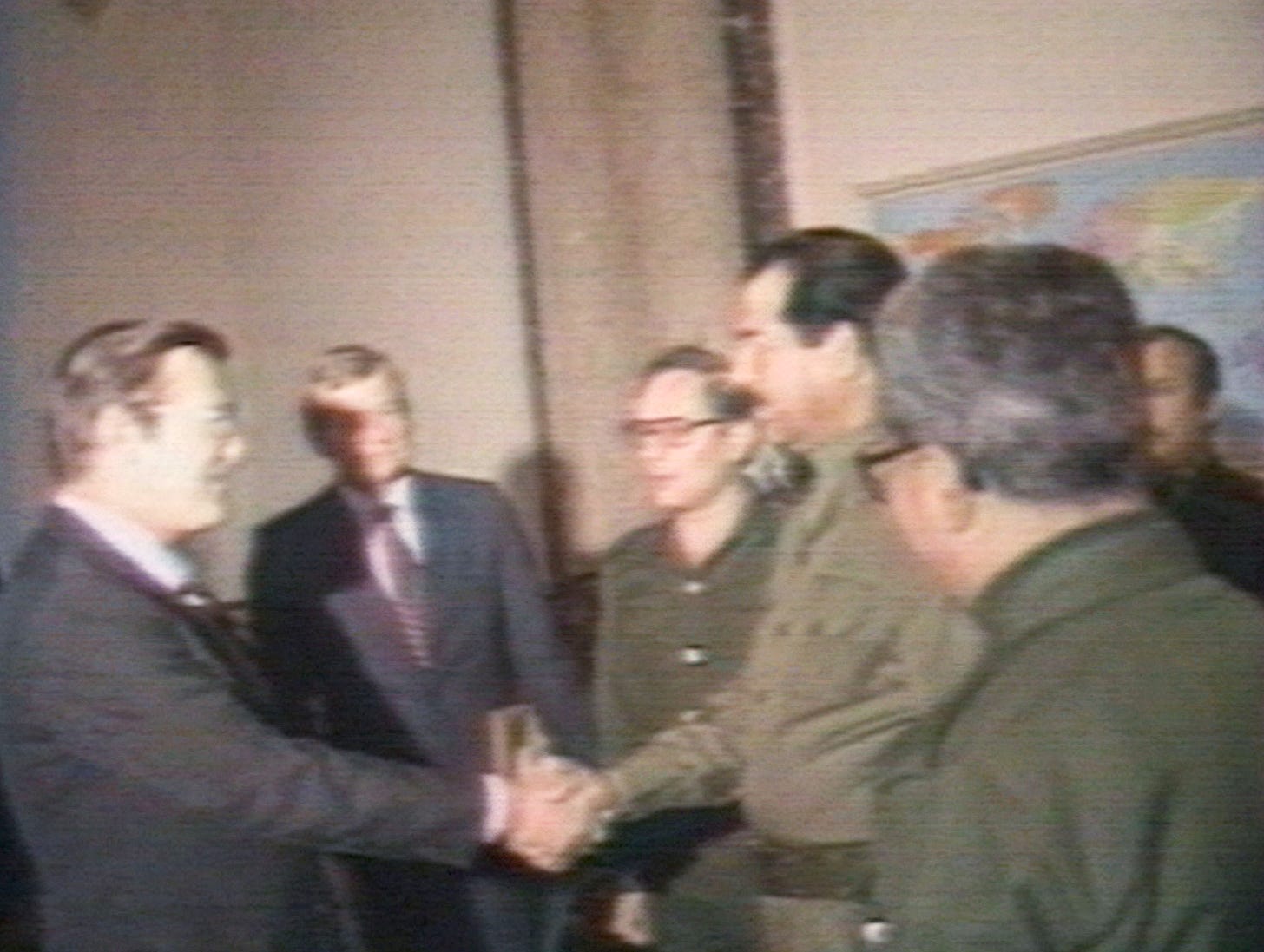While the conflict between Israel and Iran may appear to be a simple tit-for-tat exchange, it is more accurately a dangerous game of brinkmanship. Only a longue durée perspective can reveal the underlying strategic objectives at play. Such an approach allows us to contextualize not only the region's trajectory but also the fundamental shifts in global power dynamics now unfolding.
Following the Israeli strike on Iran on June 13, Washington's initial response was to deflect from its role by labeling the attack "unilateral." However, within ten days, the narrative shifted, all while a pre-fabricated justification for American intervention was being put into place. The U.S. establishment resigned itself to pursuing a decisive confrontation, or at the very least, a significant show of force.
The conflict between Iran and Israel is best understood as a manufactured symbiosis between two "functional enemies," a dynamic created to uphold a Western-led regional order, now collapsing. This architecture, orchestrated by Western powers, facilitated balance and mutually assured containment. While their rivalry has often resembled a performance between marionettes on stage, the consequences were never merely theatrical. The price of this manufactured conflict has always been paid on the ground, measured in the existence, or cessation, of human life.

Before the 1979 Iranian revolution, Iran and Israel maintained a pragmatic and often cooperative relationship, which stands in stark contrast to their current hostility. Tehran’s recognition of Israel in 1950 was driven by a need for alliances, security, and trade, and the Shah viewed Israel as a means to improve his relations with the US. Israel, seeking to end its isolation in the Middle East, pursued relations with non-Arab states at the 'edges' of the region, a strategy known as the 'Periphery Doctrine'. Both Iran and Israel perceived common security imperatives, including a shared threat from Arab nationalist states and in the broader Cold War context, from the Soviet empire, aligning as a secular base against communism.1
Ironic then, that in 1955 and 1957, the U.S. and Iran signed civilian nuclear cooperation agreements under the U.S. Atoms for Peace Program. This initiative provided technical assistance, leased enriched uranium, and facilitated joint research on peaceful nuclear energy uses. Under these agreements, Iran received enriched uranium and plutonium for its Tehran Research Reactor (TRR), which U.S. firms helped make fully operational by 1967.
“The U.S. viewed providing other countries with the technology as a means of gaining influence over those states and achieving political goals.”2
The 1979 Islamic Revolution initially seemed to end Iran's nuclear ambitions, as the new provisional government put the program on hold. However, the brutal eight-year war with Iraq forced a dramatic reversal. Facing threats of "unimaginable power" from a U.S.-backed Saddam Hussein, Iran's leaders found themselves in a fight for survival.3
The turning point came with Iraq’s use of chemical weapons; the international response was a profound betrayal. Washington, after a brief condemnation, began to actively spread disinformation, blaming both sides equally and effectively exonerating Iraq.
“Donald Rumsfeld, President Ronald Reagan’s special envoy to the Middle East, undercut this stern message when he traveled to Baghdad to explain that Washington’s position had been merely one of principle. Rumsfeld assured Iraq’s foreign minister, Tariq Aziz, that the Reagan administration’s support for the war against Iran and normalization of relations remained 'undiminished'.”

For the young Islamic Republic, this experience left a deep and lasting scar. The lesson was clear and harsh: never again be so vulnerable, and never trust international treaties for protection against a superpower. As one analysis notes, Iran felt "right and yet scorned."4
Driven by this profound sense of isolation and injustice, Tehran decided to renew its efforts to complete its nuclear reactors and build a self-sufficient program. The world's failure to act on Iraq's chemical weapons use left it with little moral authority to challenge Iran's new direction. From the Iranian perspective, a domestic deterrent was the only logical response in a region where other powers, like Israel, were believed to possess their own weapons of mass destruction.
Israel possesses a secret nuclear arsenal while refusing to join the Nuclear Non-Proliferation Treaty (NPT). Instead of enforcing nonproliferation norms, the U.S. has deliberately concealed this fact through a "campaign of censorship, lies, and disinformation." This double standard undermines America's nonproliferation policy in the Middle East and fuels Iran’s distrust of international treaties.5
Ultimately, whether the U.S. intended to create a new adversary is debatable, but its strategic double standards and aggressive containment policies after the revolution did just that. Washington inadvertently fueled the very determination for a nuclear deterrent it now works to contain. In a very real sense, the U.S. helped create the "bogeyman" that has become a central focus of regional and international tension.
In hindsight, Iran's strategy of "controlled chaos" provided a constant justification for Israel to present itself as a regional pillar of stability. At the same time, Iran's revolutionary rhetoric and its network of alliances—the "Axis of Resistance"—created a security threat that fueled business for defense contractors and extended the rationale for a continued American military presence in the region.
المُخبر الاقتصادي+ | لماذا تندفع إيران بقوة نحو القنبلة النووية وحدها دون العرب؟
Translation: The Economic Informer + | Why is Iran Strongly Rushing Towards the Nuclear Bomb Alone Without the Arabs?

After 53 years of authoritarian rule, Syria's Assad regime fell, its collapse unfolding against the backdrop of the events of October 7th. “Once the guarantors of Assad’s rule, Russia and Iran became witnesses to his last days in Syria.” Israel’s assault on Gaza spilled over to Yemen and Lebanon, weakening Iran's key proxy forces.
Gulf Arab states, especially Saudi Arabia and the UAE, have grown increasingly alarmed at what they see as Iranian assertiveness and an aggressive bid for regional hegemony. The fallout from a war could put their oil, gas, energy and US bases at risk, all within Iranian reach. On the other hand, wary of their own populous mobilizing, entertaining the idea of normalization has become a cautious matter in light of Israel’s genocide in Gaza and its radical expansionist ambitions. “In some countries, like Egypt, the ruling elite have now all but separated themselves from their own people by building new capital cities and other megaprojects that symbolise their physical separation from the nation.”6
Middle East: Order (and disorder) after Gaza and Syria. Le Monde Diplomatique.
A major diplomatic consequence of the war in Gaza has been the dramatic return of the Palestinian issue to the world stage. Western governments, which had largely sidelined the issue following the Abraham Accords, now face renewed global interest in the Palestinians' future. This is evident in the legal battles at the ICJ and ICC, and in the growing number of European countries prepared to recognize a Palestinian state.
This diplomatic upheaval, however, is just one symptom of a collapsing regional architecture. The other is the violent unraveling of the long-standing dynamic between Iran and Israel. With both sides now launching direct military strikes, the carefully managed role of Iran as a "functional enemy" is over. The era of trading slogans instead of missiles has ended, and the entire regional framework built upon these unspoken rules is collapsing. In this new reality, it is not just Iran's role that is shifting; Israel's will be redefined as well. This reveals the fundamental flaw of the "New Middle East" project: it attempts to impose order by centering a state that, by its very nature as a colonial enterprise, functions as a flashpoint for perpetual conflict. Now, that flashpoint threatens to consume the entire structure. Today, Israel’s strategic enemy has thrown Netanyahu a lifeline from the very grave he dug for himself — allowing him to transform from the supervillain into the supposed savior.
Glory to all the innocent lives lost due to never-ending wars and the struggle for freedom and dignity.
Want to learn more about…
Control over Iranian narrative, read Everyday Iranians by Africa is a Country
Agony of an Iranian in exile, read Watching Iran: Paralyzed at Dawn by Jadaliyya
Iranian radical theory, populist mobilization, and feminist movement, read Radical Iranian Theory and Praxis Microsyllabus by The Abusable Past
Maziar Motamedi, "Iran and Israel: From Allies to Archenemies, How Did They Get Here?," Al Jazeera, November 6, 2023, https://www.aljazeera.com/news/2023/11/6/iran-and-israel-from-allies-to-archenemies-how-did-they-get-here.
Becky Little, "How America Jump-Started Iran's Nuclear Program," History.com, last modified January 31, 2025, https://www.history.com/articles/iran-nuclear-weapons-eisenhower-atoms-for-peace.
"Middle East Nuclear Issue in Global Perspective," Middle East Policy (Fall 1995), accessed via The Free Library, June 20, 2025, https://www.thefreelibrary.com/Middle+East+nuclear+issue+in+global+perspective.-a017975794.
Amir Mohammad Haji-Yousefi, "Iran’s Nuclear Posture and the Scars of War," Middle East Report, January 10, 2005, https://merip.org/2005/01/irans-nuclear-posture-and-the-scars-of-war/.
Haji-Yousefi, "Iran’s Nuclear Posture."
Hicham Alaoui, "Middle East: Order (and Disorder) after Gaza and Syria," Le Monde Diplomatique, June 2025, https://mondediplo.com/2025/06/01middle-east.





